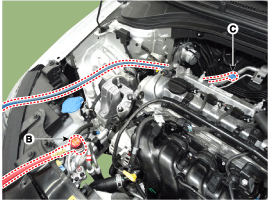Hyundai Elantra: Air Conditioning System / Repair procedures
| Refrigerant System Service Basics |
Refrigerant Recovery
Use only service equipment that is U.L-listed and is
certified to meet the requirements of SAE J2210 to remove
HFC-134a(R-134a) from the air conditioning system.
| • |
Air conditioning refrigerant or lubricant vapor can irritate your eyes, nose, or throat. |
| • |
Be careful when connecting service equipment. |
| • |
Do not breathe refrigerant or vapor. |
|
If accidental system discharge occurs, ventilate work area before resume of service.
Additional health and safety information may be obtained from the refrigerant and lubricant manufacturers.
| 1. |
Connect an R-134a refrigerant
Recovery / Recycling / Charging System (A) to the
high-pressure service port (B) and the low-pressure service port (C) as
shown, following the equipment manufacturer's instructions. 

|
| 2. |
Measure the amount of refrigerant oil removed from the A/C
system after the recovery process is completed. Be sure to install the
same amount of new refrigerant oil back into the A/C system before
charging. |
System Evacuation
Use only service equipment that is U.L-listed and is
certified to meet the requirements of SAE J2210 to remove
HFC-134a(R-134a) from the air conditioning system.
| • |
Air conditioning refrigerant or lubricant vapor can irritate your eyes, nose, or throat. |
| • |
Be careful when connecting service equipment. |
| • |
Do not breathe refrigerant or vapor. |
|
If accidental system discharge occurs, ventilate work area before resume of service.
Additional health and safety information may be obtained from the refrigerant and lubricant manufacturers.
| 1. |
When an A/C System has been opened to the atmosphere, such as
during installation or repair, it must be evacuated using an R-134a
refrigerant Recovery / Recycling / Charging System. (If the system has
been open for several days, the receiver / dryer should be replaced, and
the system should be evacuated for several hours.) |
| 2. |
Connect an R-134a refrigerant
Recovery / Recycling / Charging System to the high-pressure
service port and the low-pressure service port as shown, following the
equipment manufacturer's instructions. |
| 3. |
If the low-pressure does not reach more than 93.3 kPa (700
mmHg, 27.6 in.Hg) in 10 minutes, there is probably a leak in the system.
Partially charge the system, and check for leaks (see Refrigerant Leak
Test). |
| 4. |
Remove the low pressure valve from the low-pressure service port. |
System Charging
Use only service equipment that is U.L-listed and is
certified to meet the requirements of SAE J2210 to remove
HFC-134a(R-134a) from the air conditioning system.
| • |
Air conditioning refrigerant or lubricant vapor can irritate your eyes, nose, or throat. |
| • |
Be careful when connecting service equipment. |
| • |
Do not breathe refrigerant or vapor. |
|
If accidental system discharge occurs, ventilate work area before resume of service.
Additional health and safety information may be obtained from the refrigerant and lubricant manufacturers.
| 1. |
Connect an R-134a refrigerant
Recovery / Recycling / Charging System to the high-pressure
service port as shown, following the equipment manufacturer's
instructions. |
| 2. |
Add the same amount of new refrigerant oil to system that was
removed during recovery. Use only specified refrigerant oil. Charge the
system with 500 ± 25 g (17.6 ± 0.88 oz.) of R-134a refrigerant. Do not
overcharge the system the compressor will be damaged. |
Refrigerant Leak Test
Always conduct a leak test with an electronic leak detector
whenever leakage or refrigerant is suspected and when conducting service
operations which are accompanied by disassembly or loosening or
connection fittings.
|
In order to use the leak detector properly, read the manual supplied by the manufacturer. |
If a gas leak is detected, proceed as follows:
| 1. |
Check the torque on the connection fittings and, if too
loose, tighten to the proper torque. Check for gas leakage with a leak
detector (A). |
| 2. |
If leakage continues even after the fitting has been
tightened, discharge the refrigerant from the system, disconnect the
fittings, and check their seating faces for damage. Always replace, even
if the damage is slight. |
| 3. |
Check the compressor oil and add oil if required. |
| 4. |
Charge the system and recheck for gas leaks. If no leaks are found, evacuate and charge the system again. 
|
Component Location Index
Engine Room
1. Expansion valve2. Service port (Low pressure)3. Service port (High pressure)4. A/C Pressure transducer (APT)5. Compressor6. Discharge hose 7. Suction & ...
 Description and Operation
Description and Operation Components and Components Location
Components and Components Location




